AUTUMN DRILLING GOES TO PLAN ON THE CLAYDON FARM DESPITE THE WETTEST OCTOBER ON RECORD

As part of his series detailing the farming year on E. T. Claydon & Sons’ arable enterprise in Suffolk, Jeff Claydon, who invented the Opti-Till® direct strip seeding system, talks about establishing winter crops during the very challenging autumn and cover crop trials on the farm. The article was written in midNovember.
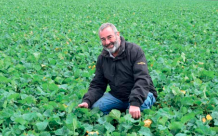
In the last issue of Direct Driller, I said that UK farmers would be glad to see the back of 2019/20 and be hoping for better weather to establish autumn-sown crops for 2020/21. Unfortunately, for many, those hopes were dashed. Remarkably, more rain fell in October than the same period in 2019. Who on earth would have expected that? On 3 October, Britain suffered its wettest day ever. An average 31.77mm of rain fell across the country, the highest since 1891. In Suffolk, we got off relatively lightly, but even so by mid-October were within 10mm of our monthly average.
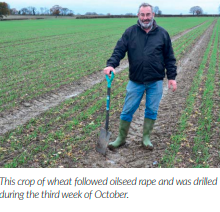
Our weather station recorded 521.7mm from 1 January to 31 December 2019. By November this year, we were close to 600mm, almost half that falling between harvest and now, with six weeks of the year to go. And Suffolk is one of driest parts of the UK! Despite that, we completed all our planned winter sowings. Being able to drill at all has been the key this autumn, as last. That has depended totally on operating a flexible system with sufficient capacity to get the job done quickly and efficiently, whatever the weather. The Claydon System has been designed to cope with these challenges. The Hybrid drill, for example, has masses of clearance between tines and can be easily tailored to provide optimum results across the widest range of crops, conditions, and soil types. To see how effective it is check out the videos of demonstrations we carried out this season at www.claydondrill.com/ video-gallery.
All Went To Plan
We have 46ha of oilseed rape this season. Of that, 40ha were drilled using 4.5kg/ha of farm-saved LG Aspire. The remaining 6ha was divided into three 2ha blocks to trial new hybrid varieties.
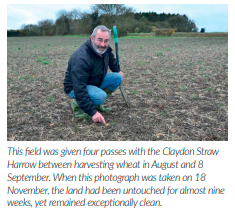
No stubble management was carried out before drilling, which is unusual, but with daytime temperatures over 30°C we wanted to conserve moisture. The crop also went in early because in 2019 we found that drilling on 10 August, compared with 10 days later, produced an additional 0.25t/ha. All the rape was drilled on 8 and 9 August, directly into chopped wheat straw using our 6m Claydon Hybrid, with 120kg/ha of Agristart granular fertiliser going down the back of the seeding tine and into the seeded bands to get the plants off to a quick start and maximise their root systems in the early stages. Then we double-rolled to promote good seed to soil contact. We had five days when temperatures peaked at a worrying 36°C, but after 25mm of rain the following week the crop jumped out of the ground. It grew away rapidly and did not get hit by the dreaded flea beetle at the vulnerable cotyledon stage.
The beetles came in late and by then the crop was at the four-leaf stage, so our early drilled rape was of little interest and has looked fantastic all season. That was not the case on the trial plots, which were drilled 10 days later and got clobbered, so early drilling paid off! We applied 4kg/ha of slug pellets a week after drilling, then on 1 September a mix of Panarex, a systemic foliar applied graminicide, Balkar®, Corteva’s postemergence autumn applied herbicide, and Toil, a 95% methylated rapeseed adjuvant oil.

On 7 November, Kerb (Corteva) was applied to control grass and broad-leave weeds, with Ultraline for Light Leaf Spot. When I went around the farm today (18 November) the temperature was still 10°C and the crop canopy prolific. I suspect that regular pigeon patrols will be required once the weather turns cold!
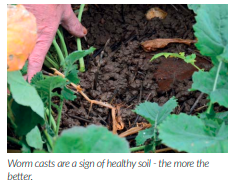
Assessing Stubble Management
Once last season’s oilseed rape had been harvested, we started straw harrowing to distribute the chopped straw evenly and create a fine, level, 2cm-deep tilth with the high-humidity conditions required to get volunteers and weed seeds to germinate quickly. Four passes at 7 to 10-day intervals, the last on 10 September, substantially reduced volunteers and weeds. We left it two to three-weeks to give the plants time to develop and provide the maximum target area for the full-rate glyphosate which went on two days before winter wheat was drilled with our Claydon Hybrid. Because harvest was so early, some fields were drilled with catch crops, but behind oilseed rape they became overthick with volunteers and had to be terminated sooner than planned. That also happened after the beans, where volunteers grew knee high.
Frequent rain meant that after 25 September we had no ‘clean wheels’ on any equipment and held off drilling the 155ha of winter wheat anticipating drier weather. But we were out of luck and with no more than a day or two between heavy downpours had to press on regardless. Drilling started on 18 October, about 10 days later than we had hoped for. The soil was wetter and stickier than we would have liked, and normally we would not drill in those conditions, but there was no alternative. That was a good decision, because had we waited the crop would have been even more difficult to drill. Almost all the winter wheat area is into LG Skyscraper. The seed was farmsaved, cleaned by a mobile processor, and treated with Beret Gold (Syngenta). Because of the wet conditions and later drilling we decided to up the rate slightly to 350/m2, which has paid off because every field looks tremendous.
A Challenging Season
Despite frequent rain, everything we planned to drill this autumn was drilled over a 10-day period by the end of October, along with 60ha of wheat and oilseed rape on a contract farm and 300ha for neighbouring farms. We were able to do this due to the high output of our 6m Claydon Hybrid and its ability to work in adverse conditions. Its support wheels run on firm, undisturbed stubbles and do not touch moved soil, so it will operate when most other strip till, min till and non-disturbance drills are stood in the shed. Warm, wet weather throughout October and November saw our crops grow away unchecked and they look very acceptable going into the colder months.
We also managed to apply all our postemergence herbicides. Half the area was sprayed with Liberator (Bayer) and Crystal (BASF), the remainder with Pontos (BASF) and Flyflo (Gemini Agriculture). Our spray programme is up to date, a huge bonus in an extremely difficult season. The key is that our 5000-litre, 24m selfpropelled sprayer can travel on the land without creating deep ruts. The Claydon Hybrid drill leave 40% to 60% of the soil unmoved, so even heavy following machinery leaves barely a mark.
Managing By Conditions

When it came to getting crops in the ground this autumn the winners were those who either did nothing in the way of cultivations or ploughed early and drilled up close behind before it turned into a soggy mess. However, working hard ground after harvest would have involved burning lots of diesel and tearing through wearing metal, as well as being harmful to soil structure and earthworm populations.
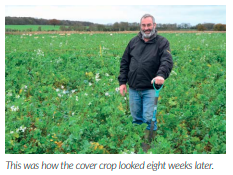
On farms where large areas of soil were moved to any depth, whether by ploughing or min-till, fields never had the chance to dry out because of the incessant rain and establishing crops became much more difficult, if not impossible. Those who min-tilled were probably hardest hit. Unfortunately, loose soil absorbed the water like a large sponge with no carrying capacity, and that is exactly what happened on many farms.
Many crops drilled in less than ideal conditions will have suffered the soil slumping and lack of air, resulting in nonexistent or poor establishment. Similarly, where disc-type or no-till drills were used in wet conditions the results can be poor because compaction will not have been alleviated and water will not have been able to drain away, so the seed rots in the rows and its development is compromised.
Look Ahead To Spring
This season we have 55ha allocated for spring sowing, all oats. They are inexpensive and easy to grow, often producing a margin on a par with winter wheat. Some of the area has been straw harrowed up to four times and then left. On some we have sown a cover crop. The idea is to see if, and by how much, cover crops improve yield and overall margin from the following crops, so we will measure the yield from each area at harvest. Obviously, if spending around £100/ha on seeds and establishment, then having to spray it off, we need to see clear agronomic and financial benefits.
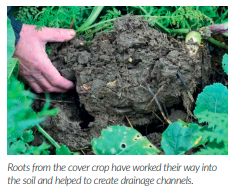
We chose Hutchinsons MaxiCover costing £35/ha, a general-purpose overwinter mix containing linseed, buckwheat, phacelia, daikon radish, fodder radish, brown mustard, hairy vetch, and crimson clover. It was drilled at 12.5kg/ha on 9 August using three seeding options on our 3m Claydon Hybrid test drill. In one area we used the standard Claydon Opti-Till® set-up comprising a patented leading tine which relieves compaction and aerates the soil, followed by a seeding tine with a 20cm A-share. In another we used the leading tine followed by our twin-tine kit. The third was drilled with the new lower-disturbance ‘LD’ twintine kit preceded by double front cutting discs which reduce power requirement and minimise soil disturbance.
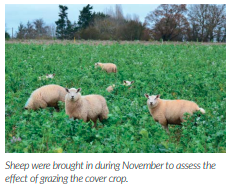
Early on when the soil was dry the lower-disturbance option did a good job, so for some farms with healthy soils and in suitable conditions that might be the best choice. But this autumn, on this farm, the standard Claydon Opti-Till® set-up produced better results. The crop established faster and was more prolific. Later in this very wet season, the leading tine created more soil fissuring, so water drained away more quickly, and the crop developed a better rooting structure. Ideally, we want the cover crop to be in the ground long enough to gain maximum advantage from the rooting structures, but not so long so that it generates excessive stick-like biomass. Some that we drilled early for demonstration purposes did just that, requiring extra work and cost to deal with it, so we will not be repeating that approach.
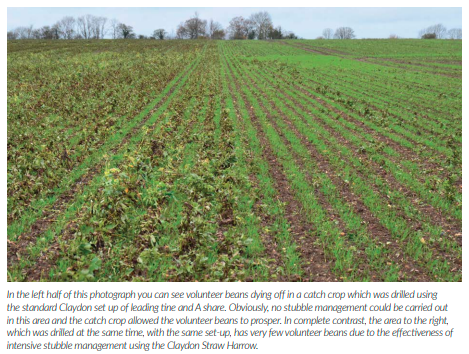
We will also avoid any cover crop that contains too much mustard, which tends to become sticky when it dies off and makes drilling more difficult. The ideal approach seems to be a mix of plant types which degrade easily and are easily incorporated, like those in Hutchinsons MaxiCover. Cover crops will be sprayed off at the end of November and those areas left until spring, when we will drill spring oats directly when conditions allow. The variety will be WPB Elyann (KWS). The last two autumns have emphasised the importance of adapting stubble management and drilling operations to suit prevailing weather conditions.
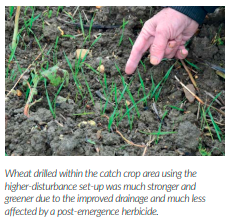
There is no one-size-fits-all ‘blueprint’ so it is critical to know your soils intimately and adapt accordingly.

The good news for Claydon customers is that with a few simple, quick, low-cost modifications any new or existing Hybrid drill can now be used for conventional sowing, lower disturbance establishment and zero-till seeding, with or without fertiliser placement between or in the seeded rows, directly into stubbles, chopped straw, cover crops and grassland. This makes them a much more versatile, cost-effective solution compared with having to purchase a strip till drill and specialist low-disturbance drill.
Find out more about the Claydon Opti-Till® System from your local Claydon dealer, the Claydon office on 01440 820327 or the website: www. claydondrill.com